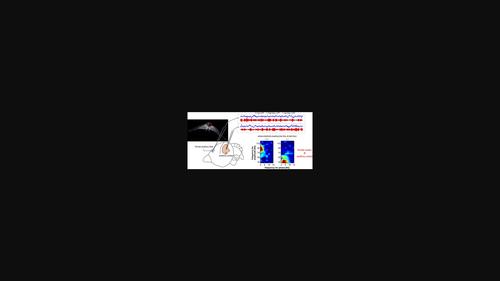当前位置:
X-MOL 学术
›
Eur. J. Neurosci.
›
论文详情
Our official English website, www.x-mol.net, welcomes your
feedback! (Note: you will need to create a separate account there.)
Phase-amplitude coupling profiles differ in frontal and auditory cortices of bats
European Journal of Neuroscience ( IF 2.7 ) Pub Date : 2020-09-26 , DOI: 10.1111/ejn.14986 Francisco García-Rosales 1 , Luciana López-Jury 1 , Eugenia González-Palomares 1 , Yuranny Cabral-Calderín 2 , Manfred Kössl 1 , Julio C Hechavarria 1
European Journal of Neuroscience ( IF 2.7 ) Pub Date : 2020-09-26 , DOI: 10.1111/ejn.14986 Francisco García-Rosales 1 , Luciana López-Jury 1 , Eugenia González-Palomares 1 , Yuranny Cabral-Calderín 2 , Manfred Kössl 1 , Julio C Hechavarria 1
Affiliation

|
Neural oscillations are at the core of important computations in the mammalian brain. Interactions between oscillatory activities in different frequency bands, such as delta (1–4 Hz), theta (4–8 Hz) or gamma (>30 Hz), are a powerful mechanism for binding fundamentally distinct spatiotemporal scales of neural processing. Phase-amplitude coupling (PAC) is one such plausible and well-described interaction, but much is yet to be uncovered regarding how PAC dynamics contribute to sensory representations. In particular, although PAC appears to have a major role in audition, the characteristics of coupling profiles in sensory and integration (i.e. frontal) cortical areas remain obscure. Here, we address this question by studying PAC dynamics in the frontal-auditory field (FAF; an auditory area in the bat frontal cortex) and the auditory cortex (AC) of the bat Carollia perspicillata. By means of simultaneous electrophysiological recordings in frontal and auditory cortices examining local-field potentials (LFPs), we show that the amplitude of gamma-band activity couples with the phase of low-frequency LFPs in both structures. Our results demonstrate that the coupling in FAF occurs most prominently in delta/high-gamma frequencies (1-4/75-100 Hz), whereas in the AC the coupling is strongest in the delta-theta/low-gamma (2-8/25-55 Hz) range. We argue that distinct PAC profiles may represent different mechanisms for neuronal processing in frontal and auditory cortices, and might complement oscillatory interactions for sensory processing in the frontal-auditory cortex network.
中文翻译:

蝙蝠额叶和听觉皮层的相位幅度耦合曲线不同
神经振荡是哺乳动物大脑中重要计算的核心。不同频段的振荡活动之间的相互作用,例如 delta (1-4 Hz)、theta (4-8 Hz) 或 gamma (>30 Hz),是结合根本不同的时空尺度的神经处理的强大机制。相位幅度耦合 (PAC) 就是这样一种似是而非且描述良好的相互作用,但关于 PAC 动力学如何对感官表征做出贡献还有很多待发现。特别是,尽管 PAC 似乎在试听中起主要作用,但感觉和整合(即额叶)皮层区域的耦合轮廓特征仍然不清楚。在这里,我们通过研究前额听觉领域(FAF;千里香。通过检查局部场电位 (LFP) 的额叶和听觉皮层中的同步电生理记录,我们表明伽马带活动的幅度与两种结构中的低频 LFP 的相位耦合。我们的结果表明,FAF 中的耦合在 delta/high-gamma 频率 (1-4/75-100 Hz) 中最显着,而在 AC 中,耦合在 delta-theta/low-gamma (2-8 /25-55 赫兹)范围。我们认为,不同的 PAC 配置文件可能代表额叶和听觉皮层神经元处理的不同机制,并且可能补充额叶 - 听觉皮层网络中感觉处理的振荡相互作用。
更新日期:2020-09-26
中文翻译:

蝙蝠额叶和听觉皮层的相位幅度耦合曲线不同
神经振荡是哺乳动物大脑中重要计算的核心。不同频段的振荡活动之间的相互作用,例如 delta (1-4 Hz)、theta (4-8 Hz) 或 gamma (>30 Hz),是结合根本不同的时空尺度的神经处理的强大机制。相位幅度耦合 (PAC) 就是这样一种似是而非且描述良好的相互作用,但关于 PAC 动力学如何对感官表征做出贡献还有很多待发现。特别是,尽管 PAC 似乎在试听中起主要作用,但感觉和整合(即额叶)皮层区域的耦合轮廓特征仍然不清楚。在这里,我们通过研究前额听觉领域(FAF;千里香。通过检查局部场电位 (LFP) 的额叶和听觉皮层中的同步电生理记录,我们表明伽马带活动的幅度与两种结构中的低频 LFP 的相位耦合。我们的结果表明,FAF 中的耦合在 delta/high-gamma 频率 (1-4/75-100 Hz) 中最显着,而在 AC 中,耦合在 delta-theta/low-gamma (2-8 /25-55 赫兹)范围。我们认为,不同的 PAC 配置文件可能代表额叶和听觉皮层神经元处理的不同机制,并且可能补充额叶 - 听觉皮层网络中感觉处理的振荡相互作用。











































 京公网安备 11010802027423号
京公网安备 11010802027423号